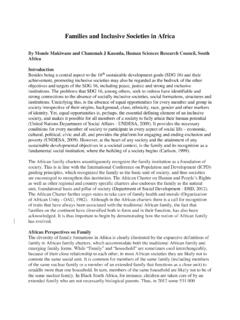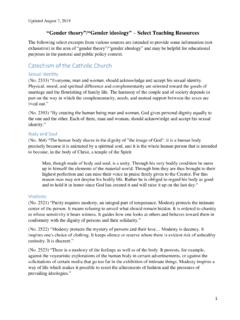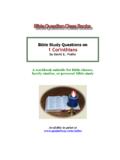Transcription of HISTORY AND DEFINITION OF STRESS ... - SAGE Publications …
1 HISTORY AND DEFINITION OF STRESS THEORYPA RT IPart I of this book consists of two chapters. The first chapter gives a brief overview of the HISTORY of STRESS theory. The second chapter attempts to clarify definitions of This chapter presents the HISTORY of STRESS theory, a relatively new theory that is still evolving. Although limited to dealing with one major aspect of clients lives, STRESS theory s applicability is far-reaching (Ingoldsby, Smith, & Miller, 2004, p. 147). The terms STRESS theory and crisis theory have been used interchangeably. This text uses the term STRESS theory as the title acknowledges that, although sometimes STRESS is of crisis proportions, STRESS is not always of that theory is an explanation of observations (Babbie, 2004) that can show us how to intervene (Burr, 1995), predict behavior, and guide research.
2 There are different types of theories. STRESS theory is a social theory that explains observations about STRESS , an aspect of social life. Theories use con-cepts that represent classes of phenomena to explain observations. A vari-able, a special type of concept that varies, is composed of a set of attributes (Babbie, 2004). The attributes male and female compose the variable gen-der as gender varies from male to female. When we put together concepts showing their relationships, we form conceptual frameworks or models. Chapters in Part II of this book include conceptual frameworks/models of STRESS theory. Although STRESS theory is a relatively new development, most likely people have dealt with STRESS since the beginning of the human (1987) points out that in the Talmud and the Bible, we read that families have been concerned with events of change, trouble, disas-ter, and ambiguity since the beginning of recorded time (p.)
3 696). Early STRESS researchers in England wrote considerably on problem families, 1 The HISTORY of STRESS TheoryC H A P T E RChapter 1 The HISTORY of STRESS Theory 3labeling them as deviant, antisocial, and lower class (Hill, 1958, p. 144). Early American researchers, in contrast to English researchers, concen-trated on the processes of family maladjustment rather than on stereo-typing families (Hill, 1958). The late 1970s through the late 1980s saw a shift in research from family weaknesses to family strengths and coping strategies (Burr, 1989). Research on STRESS not only varied in focus from weaknesses to strengths; it also varied in the unit of analysis from indi-viduals, to families, to this chapter, a brief HISTORY of the development of individual STRESS theory appears first, followed by the HISTORY of the development of family STRESS theory.
4 Although this text is primarily aimed at people interested in families, individual STRESS theory has made valuable contributions to under-standing family STRESS (Boss, 2002), and both individual and family STRESS theories are important in family STRESS STRESS TheoryContributions to individual STRESS theory came largely from psychobiology, sociology, psychiatry, and anthropology. The earlier researchers were psychobiologists, followed by sociologists, psychiatrists, and anthropologists. The models briefly discussed in this section are presented in detail in Part II of this text. See Figure for a timeline of individual STRESS theory development. We begin with the contributions of Timeline of Development of Individual STRESS TheoryTyhurst(1951)Cannon(1929)Linde-man n(1944)Sifneos(1960) Caplan(1964) Hoff (1984)HolmesandRahe(1967)192019301940195 01960197019804 PART I HISTORY AND DEFINITION OF STRESS THEORYP sychobiologyEarly psychobiologists found a connection between emotional STRESS and physiology.
5 Cannon (1929) did early experimental work showing that stimuli associated with emotional arousal led to changes in physiological processes. Later, the relationship between ordinary life events and illness was demonstrated. More recently technological advances facilitated research showing specific physiological responses to STRESS . Shortly after the work of early psychobiologists, sociologists began contributing to the STRESS (1944), a sociologist, described individual bereavement experiences of surviving relatives of those who died in the Melody Lounge Cocoanut Grove fire. In studying surviving relatives of the people who per-ished in the fire, he found that those who had positive outcomes had gone through a process. The grieving process that he observed is discussed later in Part III: Crisis Management.
6 Following the work in sociology, psychiatrists contributed to the STRESS psychiatrists contributing to STRESS theory included Tyhurst (1951, 1957a, 1957b), Caplan (1964, 1974), Holmes and Rahe (1967), and Sifneos (1960). While Tyhurst (1951, 1957a, 1957b) developed a model describing the natural HISTORY of individual reactions to disaster, which are discussed in Part II of this book, Holmes and Rahe (1967) conceived of life events as stressors, which require change in the individual s ongoing life pattern. Their Social Readjustment Rating Scale (SRRS) (Holmes & Rahe, 1967) appears in Chapter 2. To this day, the scale is used to assess vulnerability of individuals and cited in the literature ( , Lewis, Lewis, Daniels, & D Andrea, 2003). Caplan s (1974) focus on prevention of mental health disturbances was different from that of Tyhurst (1951, 1957a, 1957b) and Holmes and Rahe (1967).
7 He developed a stage theory of crisis development (Caplan, 1964), which is presented in Part II of this book. Also in Part II of this book, Sifneos model, useful in guiding crisis assessment, appears. Although psychiatric models dominated the 1950s and 1960s, the 1980s saw a contribution to STRESS theory from (1989, 1995, 2001), a nurse anthropologist, developed the Crisis Paradigm to explain what happens when individuals experience crises and Chapter 1 The HISTORY of STRESS Theory 5to help manage individual crises. The Crisis Paradigm is presented in Part II of this book. family STRESS theory developed parallel to the development of individual STRESS STRESS TheoryIndependent of the individual STRESS research summarized above, a considerable body of STRESS theory and research evolved within the family field (McCubbin, Patterson, & Wilson, 1981).
8 Burr (1989) divided the development of family STRESS theory into three stages or eras. In this book, I add the fourth era, the postmodern era. The models briefly discussed in the eras are presented in detail in Part II of this text. See Figure for a timeline of family STRESS theory First Era (1920s to Late 1940s)The first era in the development of family STRESS theory began with research in the 1920s and ended with efforts toward theory development in the mid-1940s (Burr, 1989). Graduate students did much of the early research in the 1920s while Angell, a sociologist from the University of Michigan, wrote one of the first published studies on family STRESS in 1936. The research of Cavan and Ranck (1938) from the University of Chicago followed.
9 Both studies examined the effects of the Great Depression of the 1930s on families. Both also studied families on the sociopsychological/ family level using the case study approach and induc-tive (specific to general) method to examine the effects of the stressor of the sudden loss or reduction of income on families as well as individuals (Boss, 1987).Angell (1936) found that family integration and adaptability had an impact on how families reacted to the sudden loss of income. He defined integration as the family s bonds of coherence and unity consisting of common interests, affection, and a sense of economic interdependence (p. 15) and adaptability as flexibility (vs. rigidity) in a family s structure. Adaptability consisted of philosophy of life (materialistic vs.)
10 Nonmaterialis-tic), family mores (traditional vs. nontraditional), and responsibility (irrespon-sibility vs. responsibility). He called the more adaptable families plastic families, which were the nonmaterialistic, nontraditional, responsible fami-lies. Angell distinguished three degrees of integration and adaptability pro-ducing nine types of families (highly integrated, highly adaptable; highly integrated, moderately adaptable; highly integrated, inadaptable; moderately integrated, highly adaptable; moderately integrated, moderately adaptable; 6 Figure Timeline of Development of family STRESS TheoryHill(1958)ABCXXKoos(1946)Angell(19 36)Boss(2002)Graduate studentsdidresearchCavan andRanck(1938)Hill (1949)Roller CoasterMcCubbin andPatterson(1983b)FAAR ModelBurr(1989)McCubbin and Patterson(1982)Double ABCXMcCubbinand McCubbin(1987)Typology ModelCornilleand Boroto(1992)McCubbinand McCubbin(1991)Resiliency Model19201930194019501960197019801990200 0 Chapter 1 The HISTORY of STRESS Theory 7moderately integrated, inadaptable.

















